Introduction
The use of technology in games and sports has seen numerous improvements. Over the past few years, there has been a significant improvement in the assistance offered to players through various technical means. A significant amount of statistical data is produced through match analysis, which is then used by coaching staff and player teams to prepare for matches.
We select badminton as the primary source on which the tests will be based in order to give a practical and workable solution that can be applied immediately in the real world.
A shuttlecock is hit by two players in the racket sport of badminton until one of them scores a point. In order to construct a specialized software application or program that can be adjusted for each sport, we also cover the procedures that must be taken to develop a complete, end-to-end solution that integrates various forms of data and technology.
Research
Game theory has been used to study various strategic sports in the past and most of the prevalent work done so far has been towards studying specific parts of a sport and not the entire match or game.
Two models are suggested. which uses the opponent and player under consideration’s past match data as input to provide suggestions and recommendations for a player.
- The first model of experimentation
- The first model called the recommendation system takes into consideration the various shots that the player and the opponent have played throughout their career. The main purpose of this system is to help the players gain an understanding of the different shots that the opponent plays and to gain knowledge of the best possible shots that he/she can play such that the chances of gaining a point are maximum. This model could be used by the players and coaches before going into a match and is not intended to be used during match play
- The second model of experimentation
- The second model called the Simulation model is an extension of the recommendation system but it takes into consideration the history of the match when it is in use. We use a reward system to determine the best shots for the players. This model is intended to provide match practice to the players against opponents so that they can simulate match situations and gain experience before heading into the actual match
Comprehensive data is essential to effectively model the capability and choice of players which is vital in sports. Badminton is not like board games where predefined moves or strategies can consistently help you win.
Data for this starting this research was manually collected by going through several full-match videos of the players. Matches between two of the best and most consistently performing badminton players in the world– Lin Dan from China and Lee Chong Wei from Malaysia were considered.
The following figure shows the scope of the shots that were considered.
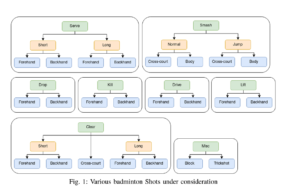
Methodology
For the purpose of modelling and easy representation, the player under consideration who uses either of the two proposed models is referred to as X_p and the player’s opponent as X_o
The recommendation tool considers X_p’s choice and capabilities based on X_p’s history with a particular opponent Xo to offer the best suggestions for each shot of X_o. The concept of best response from game theory is adopted which will help X_p to be match ready with the best and safe shots to play given any shot from X_o to maximize X_p’s chances of winning each point and in turn, winning the match.
This means that at any stage of the game, for a given shot s_{-i} of X_o, X_p will have a set of probable shots (strategies) S to play and the recommendation tool outputs that best shot (s_i)∗ from the available hots S which is the best response to s_{-i}.
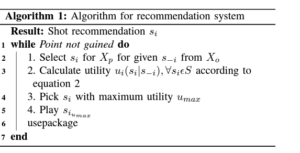
The simulator is an extension to the recommendation tool The most important value addition to this method is that the history of shots between the players X_p, X_o is taken into consideration. In badminton, it may not be the case that the last shot results in winning or losing a point; the earliest played during the rally can also be responsible for a particular outcome.
And for this, a reward system is introduced, which has four types of rewards – A high positive reward, a medium positive reward, a medium negative reward, and a low negative reward.
The rewards are hence considered with history up to two shots which will help the algorithm suggest the best possible outcome for X_p
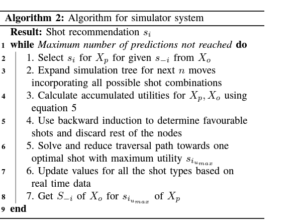
Results
As there is no established metric to verify the results of our proposed models, an expert opinion or domain knowledge is the only way to check the accuracy and correctness of the results.
The results of the recommendation system can be seen in the following two tables, one for X_p and one for X_o
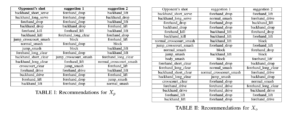
Using this model, a player can be mentally prepared on what shot to play to a given shot of the opponent that can either lead to a point or keep X_p alive in the rally to avoid losing a point
The purpose of the simulator is to take the history of the ongoing match into consideration and to model the game strategy for X_p based on the position in the match, to identify the feasible sequence of shots that has led to point gains and to avoid the poor shots. The simulator can be fed with seed shots i.e. few inputs at the start on how the game should proceed and it predicts the next few shots.
The actual sequence of shots from the match and the sequence of predicted shots from the simulator is given in the two figures below
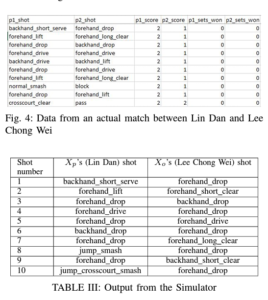
It can be seen from the tables that the results of the simulator are closer to the actual match. The results mostly differ only in the sub-category of shots and the actual type of shots are the same. This tool can help the players understand how the match will proceed after a shot is played which is crucial to analyze the repercussions of playing a shot.
Conclusion
This report successfully developed two novel approaches for the development of an assistance tool for the game of badminton based on the concepts of Game Theory. Our recommendation tool takes in match data for the player under consideration against a particular opponent and gives out the best possible set of strategies (shots) that the player can use. The simulator model is a generalized and robust extension of this recommendation tool which considers the history of shots played in the ongoing match along with match history to suggest a favourable strategy for the players. The results, analysis and comparison with the actual match data show the effectiveness of the system and that it is well-rounded
Sources
Ravi, Ambareesh, Atharva Gokhale, and Anchit Nagwekar. “Using Game Theory to maximize the chance of victory in two-player sports.” arXiv preprint arXiv:2105.11650 (2021).